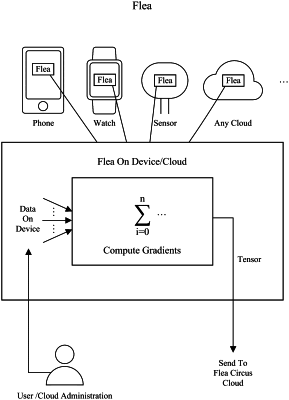| CPC G06N 3/084 (2013.01) [G06N 3/08 (2013.01); G06V 10/764 (2022.01); G06V 10/809 (2022.01); G06V 10/945 (2022.01); G06V 10/95 (2022.01); G06V 10/96 (2022.01); G16H 70/60 (2018.01)] | 20 Claims |

|
1. A system for federated learning, comprising:
multiple edge devices of end users, coupled to a communication network, each edge device comprising
a memory, that stores program instructions for a federated learner, recorded user data, and a tensor of model parameters of a deep neural network, a “DNN”; and
the federated learner, that executes on a processor of the edge device, configured to:
record end user data,
predict characteristics of the end user from the recorded end user data by applying the DNN,
receive updates from the end user that correct the predicted end user characteristics,
perform update training of the DNN using the recorded end user data and the corrected user characteristics, thereby producing a modified tensor of updated model parameters, and
send at least a modified part of the modified tensor to an FL aggregator;
a base model tensor of model parameters for the DNN running on the edge devices, trained to predict characteristics of the end users from the recorded end user data, provided to the edge devices;
the FL aggregator, coupled to a communication network, comprising a federated learner,
configured to
receive modified tensors from at least some of the edge devices,
aggregate the modified tensors with a current version of the base model tensor by federated learning to produce a new version of the base model tensor, and
distribute the new version of the base model tensor to the edge devices, and
wherein the recorded end user data includes a picture captured by the edge device, each edge device further comprising a face detector that determines whether a face appears in the picture and proceeds to perform update training only upon detection of a face in the picture.
|